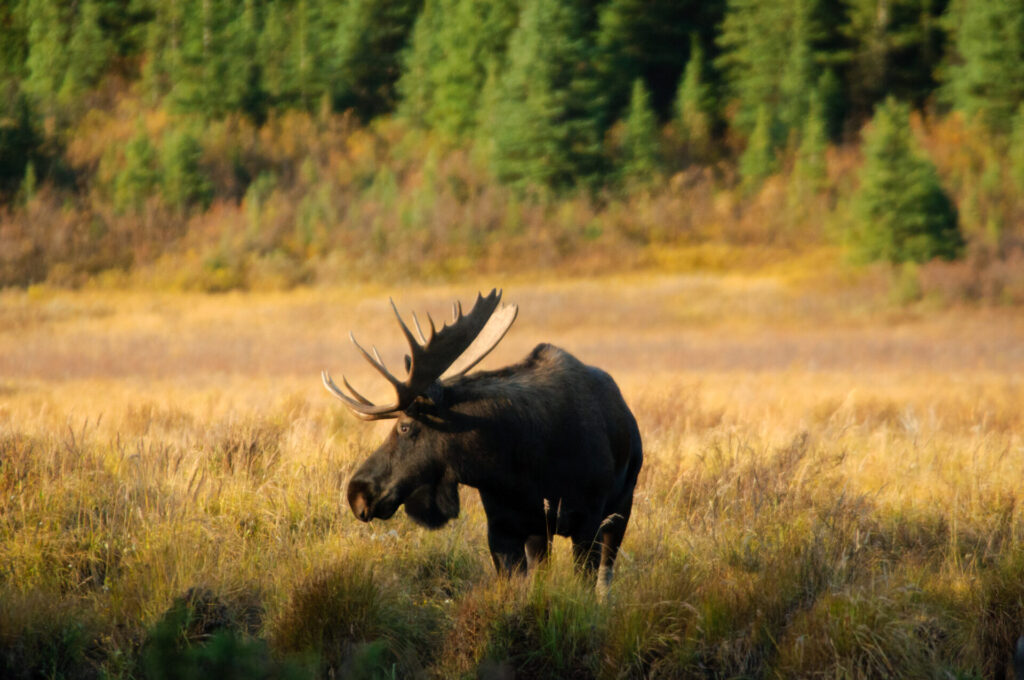The dewlap, commonly referred to as a “bell,” is one of the more distinctive physical features of a moose. This fleshy, dangling appendage hangs from the throat area of both male and female moose, though it’s often more pronounced in males. Its exact purpose is still somewhat mysterious, with researchers and wildlife enthusiasts continuing to study it to fully understand its role.

What Is The Dewlap?
The dewlap, or bell, is a flap of skin and hair-covered tissue that hangs beneath the moose’s chin and can vary in size and shape. In some moose, the dewlap appears large and pendulous, while in others, it may be relatively small or even barely noticeable. This variation can depend on the age, sex and even the individual genetics of each moose.
While both males and females have dewlaps, it tends to be larger and more prominent in adult males. During the rut, male moose may use this feature in social displays, possibly to attract females or communicate dominance over other males. However, these behaviours are still somewhat speculative, as direct observations are limited.
Possible Functions Of The Dewlap
There are several hypotheses about the purpose of the moose’s dewlap, though none have been definitively proven. Some of the most popular theories include:
- Signaling During the Rut: One theory suggests that the dewlap may play a role in visual signaling during mating season. A large, healthy dewlap could indicate a strong and mature bull, potentially making it more attractive to females and deterring other competing males. However, there isn’t strong evidence to show that females use the dewlap as a major selection criterion.
- Thermoregulation: Another hypothesis is that the dewlap aids in thermoregulation, helping to dissipate heat during warm weather. However, this theory is less widely accepted, as moose typically live in cooler climates and are adapted to colder temperatures rather than overheating. Still, the theory suggests that the blood vessels in the dewlap might help to release heat, although this has not been definitively proven.
- Scent Dispersal: During the rut, moose bulls often rub their dewlaps on shrubs, branches and even the ground. This behaviour may help disperse their scent, which is critical for marking territory and attracting mates. The presence of glands near the dewlap could assist in releasing scent molecules that linger in the environment, communicating the bull’s presence to potential mates and rivals.
- Social & Visual Identification: Since the dewlap varies in size, shape and even hair length, it might also serve as a visual identifier that differentiates individual moose. This theory, though interesting, has yet to be explored in depth in scientific studies.
Why The Dewlap Remains A Mystery
Despite these theories, no single explanation fully accounts for the purpose of the dewlap on a moose. Because it is found in both sexes and lacks a consistent role in survival or reproductive advantage, the dewlap may be a vestigial feature – something that served a purpose for ancestral moose but has since lost its function.
A Unique Feature In Moose Anatomy
The dewlap, while not fully understood, adds to the uniqueness of moose, making them a favourite among wildlife enthusiasts. As research continues, scientists may uncover more clues about this curious feature, enhancing our understanding of moose biology and the roles of seemingly minor physical characteristics in the animal kingdom. For now, the dewlap remains an intriguing and mysterious hallmark of these magnificent creatures.

